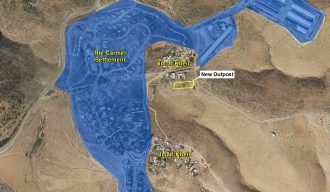*** Update from 13/10/25: One day after the court injunction was issued, settlers started to move in the caravans, violating the order. The head of the Har Hebron Settlement Municipality was documented with the settlers violating the court order. ***
The Jerusalem District Court issued today (12/10/25) a temporary order barring settlers from moving into an illegal outpost built close to the houses of the Palestinian village of Um al-Kheir in the South Hebron Hills, and prohibiting any further construction on the site. The order was issued following a petition filed by Peace Now and residents of Um al-Kheir.
The petition, submitted by attorneys Snir Klein, Anat Halpern, and Michael Sfard, demands the removal of the caravans that settlers have placed in recent weeks and seeks to prevent the opening of a new road near the village homes, intended to connect the Carmel settlement to the new outpost. The petition also calls for the removal of a fence erected by the settlers on the villagers’ private lands.
At the end of July, settlers began construction work to establish an outpost near the homes of Um al-Kheir residents. The settlers placed four caravans just a few meters from the village homes, in violation of the area’s zoning plan, and later added three more caravans. During the work to prepare the land for the outpost, a village resident, Odeh al-Hadalin, was shot dead by one of the settlers while standing dozens of meters away, documenting the events.
Peace Now: For months, all enforcement authorities have known full well about the massive, blatantly illegal construction project taking place on the village’s land — and not only did they do nothing to stop it, they actually secured and assisted it in various ways. It is depressing and sad, though not surprising, that it takes a court order to make the army and the police do their duty. We hope the order will give the residents of Um al-Kheir, who are suffering under the settlers’ ongoing harassment, some space to breathe and live normal lives.”

Background
Um al-Kheir is a Palestinian village of about 200 Bedouin residents. Their families originated in the Negev and were forced to leave their lands after 1948. They later migrated to the South Hebron Hills, where they purchased land and settled in Masafer Yatta during the Jordanian administration of the West Bank. Israel does not recognize the village as legal. The state refuses to issue building permits and considers all structures in the village “illegal.” According to OCHA, the United Nations Office for the Coordination of Humanitarian Affairs, Israel has demolished 56 structures in the village over the past 15 years.
In the early 1980s, Israel declared c. 4,000 dunams in the area as state land and allocated them to the Settlement Division for the establishment of the Carmel and Ma’on settlements. The Carmel settlement was built adjacent to the lands of Um al-Kheir. In 2005, the Higher Planning Council approved Plan 507/1 for Carmel, which expanded the settlement’s planned area to include about 2,200 dunams of surrounding open land. Around seven of those dunams lie within the village of Um al-Kheir itself, and on these 7 dunams the caravans were established. Under the plan, the area where the outpost was built is zoned for agricultural use, not for housing.
Settler Harassment of the Residents of Um al-Kheir
Residents of Um al-Kheir, like many Palestinian villages across Area C, have come under repeated attack by settlers from nearby settlements and newly established shepherd outposts. These assaults include physical violence against residents and damage to their property. The Israeli police and security forces have not acted to prevent the violence, which has already driven dozens of Palestinian communities from their homes.
In the past year, the Magistrate’s Court issued a restraining order against Shimon Attiya, a settler from the Havat Shoreshim outpost, following a petition submitted by the residents together with Peace Now. Attiya had been harassing and threatening families in their homes without any provocation on their part.
As mentioned, the peak of violence in Um al-Kheir occurred with the killing of Odeh al-Hathalin by a settler. In addition, settlers have several times destroyed the village’s water and electricity pipes, leaving the residents during the peak heat of August without water and for several days without electricity at all. Repairing the infrastructure took several days and required the intervention of the authorities, since settlers prevented the Civil Administration or the residents themselves from fixing the pipes they had deliberately broken.

